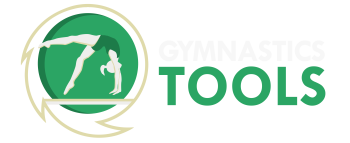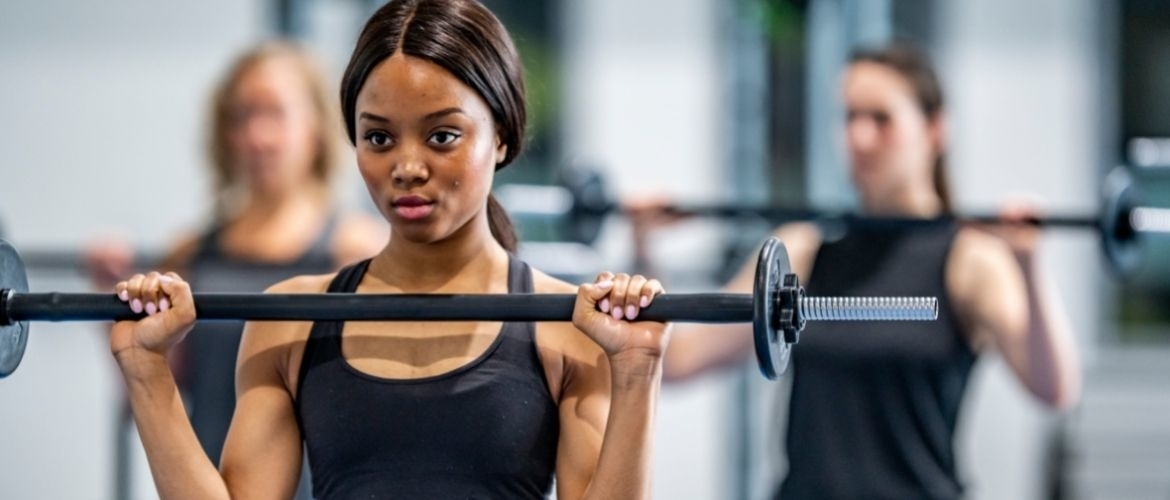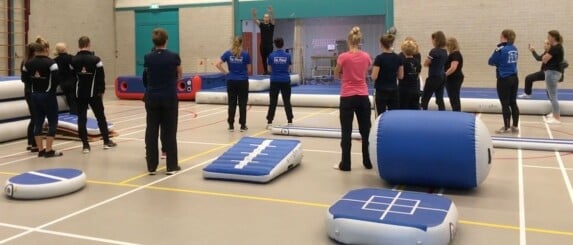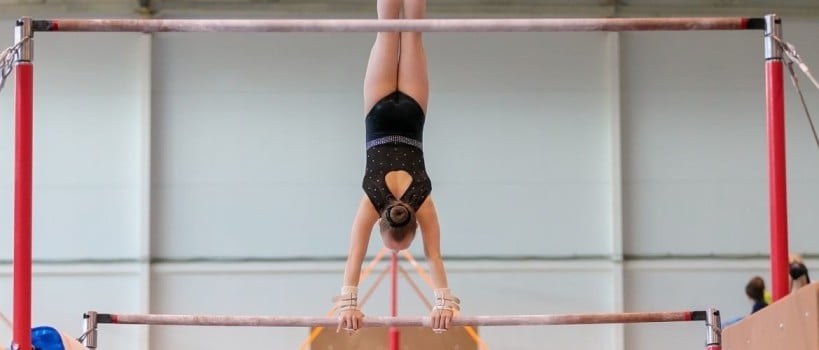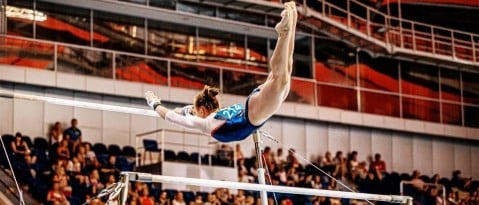Strength training often brings to mind the classic strength training exercises involving the use of dumbbells, dumb belts and other heavy weights. Strength coaches often look big and muscular. However, strength training has different training forms. It is often used in sports in order to “loosen up” the basic motor skills. In gymnastics, for example, there is often a separate block of ”physical” training where, among other things, attention is paid to strength exercises. This article discusses what strength training is exactly and how you can apply it to your gymnastics training.
What is strength?
Force literally means ”the ability of a muscle to move a load or overcome resistance” (Van den Berg, 1996). Strength is necessary to be able to endure heavy resistances. The goal of strength training is therefore to strengthen the muscles, tendons and ligaments so that they can withstand resistance and protect your joints.
Example: In order to walk on your hands, your shoulder, chest and arm muscles must have a certain strength to support your body weight so that you do not collapse.
Types of strength training methods
- Strength endurance: Overcoming a force in as many repetitions as possible.
Example: Do as many push-ups as you can. In practice, this usually means twenty to thirty repetitions of one exercise.
- Maximum force: Overcome as much force as possible in one go.
Example: Leg lifting on the stick with ankle weights. The weight must be so heavy that this can only be done one repetition. In practice, this form of strength is not very common in gymnastics.
- Rapid power: Overcome power as quickly as possible and repeat several times.
Example: When lifting the legs on the beam, get your legs to the pole as quickly as possible.
- Explosive power: Overcoming a resistance as heavy as possible as quickly as possible.
Example: A jumpsquat where you hold and lift the heaviest weight possible off the ground and then jump up.
- Sport-specific strength: Strength required to perform a task.
Example: The corner hang position training to improve your kip.
Building up strength training
The least taxing form of strength training is endurance strength training and the most taxing is specific strength training.
In your gymnastics lessons, take into account the build-up of strength. Start the season with strength training aimed at strength endurance and build this up further and further. Be aware that explosive power such as jumping forms and specific power are very taxing on the body and require good preparation.
Example: training the forward somersault
After the summer holidays, coach Sofie wants to start with methods to teach the forward salto. A forward somersault requires quick and explosive power from the leg muscles in order to gain height and initiate the forward somersault.
An example of a strength course that is in line with the training of the forward somersault is:
- Squats 3 x 20 repetitions
- Hip bridge 3 x 20 repetitions
- Calf raise 3 x 20 repetitions
- Jump squats 3 x 8 repetitions
- Explosive hip bridge 3 x 8 repetitions
- Drop jump + rebound 3 x 5 repetitions
General and specific strength training
You can use both general and specific strength training in the gymnastics lessons. General strength training can be used as a basis. It serves as a movement condition from CLUKS to prepare the body as well as possible for loading. The muscles and tendons must have sufficient coordination, flexibility, endurance, strength and speed to protect the joints and perform the movement as well as possible.
In a general strength training programme, all muscle groups are represented. In order to train all muscle groups, the following training programme can be used, based on the push-pull principle:
| Target movement | Example |
| Front legs | Squat, lunges, calf raise, deadlift |
| Rear legs | Hamstring curl, hip bridge |
| Push arms (forward, sideways and upward) | Forward: Push-up Sideways: wide push up, sideways plank Up: Dumbell press |
| Pull arms (forward, sideways and upward) | Forward: Row Sideways bicep curl Up: Pull-up |
| Belly | Cutter, crunch, russian twist |
| Back | Leg raise |
Specific strength
In gymnastics, specific strength is needed, which is reflected in several parts. For example, the closing and opening of the shoulder and hip area and the stretching and bending of the arms and legs are used. In the table below you can see the target movements described with examples from practice.
| Target movement | Example |
| Stretching the arms | Pushing off on the pegasus |
| Stretching legs | Streetsalto |
| Open shoulder angle | The transhipment |
| Close shoulder angle | The kip |
| Open hip angle | The flip-flop |
| Close hip angle | The somersault |
Specific strength exercises can be added in your lesson block to support the training of the target element and to make more turns.
Example: the kip
When training the kip, you can add exercises to train the closing of the hips and shoulder angle. In addition, you can offer form-stretching exercises for the legs and arms. Fun and useful exercises are:
- Close arms with elastic band in cup –> close shoulder angle
- Cutter –> close the hip angle, straighten the legs
- Jump on the stick with stretched arms –> arms extended
It is important that the specific strength exercises are performed with the correct technique. Incorrect technique will cause errors in the target movement. Ensure a safe performance situation by, for example, offering help from materials or assistants. Teach the gymnasts the correct form tension to perform these techniques correctly.
Repetition of strength training
It is important to repeat strength training exercises frequently in order to make progress. The supercompensation time of strength training is about 24 to 48 hours. The exact duration depends on the type of strength training. For example, you recover faster from a strength training session (+- 12 to 24 hours) than a training session focused on explosive power (+- 48 to 72 hours).
You could choose to give them a strength programme for at home. If the strength training can be done about three times a week with at least one day of rest in between, you offer a new strength stimulus in time.
Choose consciously for which gymnastics groups it is useful to perform the strength training at home. For example, for recreational gymnasts it is less important to offer extra exercises. The exercises in the gymnastics class are already strength exercises.
It is often useful to offer home exercises from two to three training sessions per week. You can choose to offer specific or general exercises. In order to prevent incorrect execution during specific strength training, a general strength training at home would be a good addition. The specific strength exercises can then be performed in a strength/condition block or on the apparatus block.
Resources
In strength training you can use tools to make exercises heavier. These include weights, sliders, elastic bands and dynabands. When training with resistance bands, there is often also a coordinating aspect to the movement execution. Doubly useful to train with!
Strength training must be sufficiently heavy to provide the right stimulus and allow the muscles to adapt to it. A muscle can only grow or strengthen when the right stimulus threshold is reached. Ask your gymnasts about this. An example of this is to let the gymnasts score the heaviness of the execution between zero and ten. For strength training you want to be around a 7/10 in terms of heaviness. The right muscles are also allowed to slightly acidify. You can often tell if an exercise is too light or too heavy. Signs of training that is too light are, for example: chattering in between, barely any increase in breathing, can still do more repetitions, no discolouration on exertion (red cheeks), no sweating.
Strength training with reaction lights
An increasingly popular training tool are the so-called reaction lights. These lights with special motion sensors are very suitable for power exercises. They also train your speed, coordination, reaction speed, balance and much more. The possibilities with these lights are endless, and very suitable to work with in every group of your gym!
To measure is to know
Measure the progress of the strength training sessions. This shows whether you are making progress and it has a motivating effect. Set up a strength-training programme that you stick to for about six weeks. Measure in weeks 1, 3 and 6 and see if you are making progress. What can you make measurable? Below is a list of training variables:
- The number of repetitions
- Weight (in kg, colour of resistance band)
- The heaviness (on a scale of 0-10)
- Muscle size
For example, make a measuring scheme in which the gymnasts themselves can keep track of their progress.
Summary of strength training in gymnastics
- Choose the type of power you want to train
- Choose general and/or specific strength training exercises
- Make a strength programme for home use if it is appropriate to the level and number of training hours.
- Use aids such as elastic bands, weights, sliders or resistance bands if necessary
- Make it measurable
- Technology comes first!
Hopefully, after reading this blog, you have gained more insight into strength training and its application in the gymnastics classroom. Please leave a comment on how you use strength training in your gymnastics classes and share your experience with other gymnasts.
Also check out the other workouts on our Youtube channel. Or check out all the exercises on the gymnastics platform.
